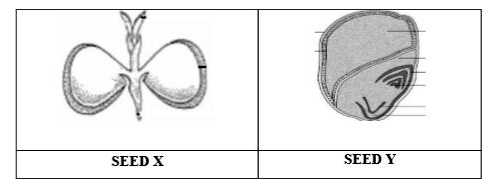Non endospermic monocot is
a) Castor and gram
b) Maize and mulethi
c) Tomato and moong
d) Orchid
Castor and gram
Maize and muliathi
Tomato and moong
Orchid
The correct Answer is:D
To determine which of the given options is a non-endospermic monocot, we can follow these steps:
Step 1: Understand the Terms
- Non-endospermic: Refers to seeds that do not have endosperm, which is the tissue that provides nutrition to the developing embryo.
- Monocot: A type of flowering plant that has a single cotyledon (seed leaf).
Step 2: Analyze the Options
We will categorize each option into monocots and dicots:
- a) Castor and gram: Both are dicots.
- b) Maize and mulethi: Maize is a monocot, but mulethi (licorice) is a dicot.
- c) Tomato and moong: Both are dicots.
- d) Orchid: This is a monocot.
Step 3: Identify Non-Endospermic Monocots
Now, we need to check which of the monocots listed is non-endospermic:
- Maize: This is an endospermic seed, meaning it contains endosperm.
- Orchid: This is known to be non-endospermic.
Step 4: Conclusion
From the analysis, the only non-endospermic monocot from the options provided is Orchid.
Final Answer
The correct answer is d) Orchid.
---
- Non-endospermic: Refers to seeds that do not have endosperm, which is the tissue that provides nutrition to the developing embryo.
- Monocot: A type of flowering plant that has a single cotyledon (seed leaf).
We will categorize each option into monocots and dicots:
- a) Castor and gram: Both are dicots.
- b) Maize and mulethi: Maize is a monocot, but mulethi (licorice) is a dicot.
- c) Tomato and moong: Both are dicots.
- d) Orchid: This is a monocot.
Now, we need to check which of the monocots listed is non-endospermic:
- Maize: This is an endospermic seed, meaning it contains endosperm.
- Orchid: This is known to be non-endospermic.
From the analysis, the only non-endospermic monocot from the options provided is Orchid.
The correct answer is d) Orchid.
Topper's Solved these Questions
- BOOK - PHYSICS WALLAHCHAPTER - MORPHOLOGY OF FLOWERING PLANTSEXERCISE - LEVEL-215videos
MORPHOLOGY OF FLOWERING PLANTS
- BOOK - PHYSICS WALLAHCHAPTER - MORPHOLOGY OF FLOWERING PLANTSEXERCISE - NEET Past 10 Years Questions54videos
MORPHOLOGY OF FLOWERING PLANTS
- BOOK - PHYSICS WALLAHCHAPTER - MOLECULAR BASIS OF INHERITANCE EXERCISE - NEET Past 10 Years Questions64videos
MOLECULAR BASIS OF INHERITANCE
- BOOK - PHYSICS WALLAHCHAPTER - NEURAL CONTROL AND COORDINATION EXERCISE - NEET Past 10 Years Questions25videos
NEURAL CONTROL AND COORDINATION
Similar Questions
Knowledge Check
- Question 1 - Select One
Assertion : Orchid is monocotyledonous non-endospermic seed while castor is dicotyledonous endospermic seed
Reason : In monocotyledonous (wheat and maize) cotyledon is one while is dicotyledonous (gram and pea) there are two cotyledons.AIf both assertion and reason are true and the reason is the correct explanation of the assertionBIf both assertion and reason are true but reason is not the correct explanation of the assertionCIf assertion is true but reason is falseDIf both assertion and reason are false - Question 2 - Select One
In flowering plants , arrange the following steps in their correct sequence .
(a) Formation of the embryo sac
(b) Megasporogenesis
(c) Formation of endosperm
(d) Fertilization
(e) Development of embryoAb→a→e→c→dBb→a→c→d→eCa→b→c→d→eDb→a→d→c→e - Question 3 - Select One
In a fertilized ovule, n, 2n and 3n conditions occur respectively in:
a) Antipodal, zygote and endosperm
b) Zygote, nucellus and endosperm
c) Endosperm, nucellus and zygote
d) Antipodals, synergids and integumentsAAntipodal, zygote and endospermBZygote, nucellus and endospermCEndosperm, nucellus and zygoteDAntipodals, synergids and integuments
(a) Name the layer which separates endosperm from embryo in a monocotyledonous seed.
(b) Where lies the cotyledon of a maize grain (monocotyledonous seed) ? What is it called ? Give its functions.View SolutionGroup the following and tabulate them as energy yielding protein yielding oil yielding and fodder crop.
Wheat rice berseem maize gram oat pigeon gram sudan grass lentil soyabean groundnut castor and mustard.View SolutionWhich of the following statements are true related to Seed X and Y?

(i) Seed X is dicot and endospermic or albuminous.
(ii) Seed X is dicot and non-endospermic or non-albuminous.
(iii) Seed Y is monocot and endospermic or albuminous.
(iv) Seed Y is monocot and non-endospermic or non-albuminous.
Choose the correct option with the respect to the nature of the seedView SolutionIn monocot stem
( a ) Vascular bundles are scattered.
( b ) Hypodermis is sclerenchymatous.
( c ) Endodermis is well developed.
( d ) Stele is atactostele.View SolutionWhich one of the PGRs would be used by farmers if they are asked to?
(a) Induce parthenocarpy in tomatoes
(b) Hastens fruit ripening in tomatoes and apples
(c ) Induces howering in mango
(d) Elongation and improvement in shape of appleView Solution

